Browse Houses
Search Results: Returned 5516 records. Displaying results 4401 – 4500
| House name | Description | |
|---|---|---|
| Raphoe Bishop's Palace | William Ker was leasing this property from the Ecclesiastical Commissioners estate at the time of Griffiths Valuation in the 1850s, when the buildings were valued at £45. The Bishop's Palace was destroyed by fire in 1838 and has remained a ruin ever since. |
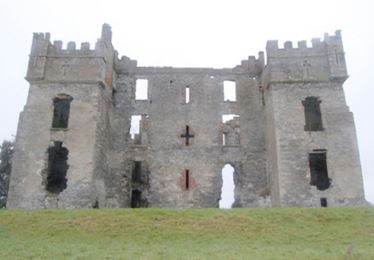
|
| Rapla | Rapla was a Freeman home in the 18th century and was inhabited for a time by the Otways, Phoebe Otway having married Daniel Freeman of Rapla. Wilson, writing in 1786, refers to Rapla as the seat of Mr. Willington. Jonathan Willington, younger brother of John of Killoskehane, was residing at Rapla in 1814 and William Cooper Crawford in 1837. William Cooper Crawford married Sophia Morgan [nee Willington] as her second husband. By the early 1850s John Tuthill was resident holding the house valued at £42+ from William Cooper Crawford. The sale rental of 1850 describes Rapla as a first class house held on a lease for 7 years from the Court of Chancery to John Tuthill. This house no longer exists. |

|
| Rappa Castle | An old Bourke castle, granted to a Cromwellian soldier named Crofton. It passed into Knox ownership through marriage and was the seat of this influential branch of the Knox family throughout the 18th and 19th centuries. In 1786 Wilson refers to it as "the pleasant seat of Mr. Knox". At the time of Griffith's Valuation it was held in fee by Annesley Knox and valued at £30. Slater notes it as the seat of Captain Annesley Knox in 1894. Occupied by the Knox family until the early 20th century, the house is now a ruin. |
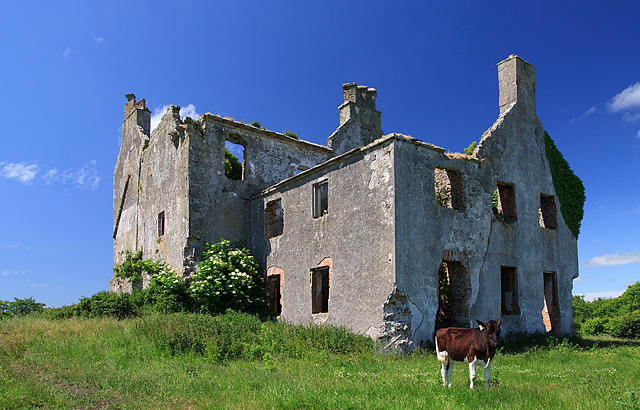
|
| Rath | Smith writes in 1750 that Rath was built by Alderman James French of Cork. Rath house was occupied by Michael Greene in the early 1850s and held from Sir Edward Tierney. It was valued at £12. To the north Rath Cottage (Grid Ref R492 147) was held by Sir Edward Tierney in fee and was valued at £14. This cottage is now a ruin and Rath House although still extant is no longer lived in, a new house having been built on the site. | |
| Rath (Fenoagh) | In 1850 Jane Bolton was leasing this property to Anne Power when it was valued at £12 15s. A farm still exists at the site. | |
| Rath House | In 1851 John Carroll was leasing this property from the Devonshire estate when it was valued at £16. Labelled as Rath House on the later 25-inch Ordnance Survey Map. | |
| Rath More House | At the time of Griffith's Valuation, Rev. Edward Walsh was leasing this property from Daniel Coltsman [Cronin], when it was valued at £17. In 1837 Lewis notes that Rathmore House was the property of D. Cronin but "now occupied by a society of monks". These were Cistercian monks, afterwards located at Mount Mellerey in county Waterford. The Cronins had lived at Rathmore until the early years of the nineteenth century before leasing it to the Order. After the monks departed it was used as the local presbytery and part of it is still extant. Denis Glissane was leasing a house in the same location from the Cronin estate, valued at £8. | |
| Rath-healy | In 1786 Wilson refers to Rath-hely as the seat of Mr. Bryan. It was the home of Arthur Hyde Lucas and his son and namesake in the 19th century. Arthur Hyde Lucas is recorded as occupier at the time of Griffith's Valuation, holding the property from John Hyde when it was valued at £20. In 1880 the property passed to Henry John Lucas, nephew of the second Arthur Hyde Lucas. Sold by the Lucas family in the 1920s and still inhabited. | |
| Rathanna | Col. Knox Barrett held this property from Jane Mullin at the time of Griffith's Valuation when it was valued at £20. It remained in the Barret family until the early 1900s when it was sold to the Monahan family who owned it until the 1960s. McTernan writes that it was sold to the Jurys Hotel Group who built the Sligo Park Hotel in front of the original house which was demolished in the 1980s. | |
| Rathanna | ||
| Rathanny | A house situated on the estate of the Earl of Limerick, occupied by John Sheeran in 1814 and by T. Bennett in 1837. Thomas F. Bennett was still resident at the time of Griffith's Valuation when the buildings were valued at £15. |

|
| Rathanny House | Elizabeth Rowan was leasing a property to Patrick Holohan at the time of Griffith's Valuation, when it was valued at almost £3. Lewis refers to Rathanny as the residence of Mrs. Rowan in 1837. In the 1830s the Ordnance Survey Name Books noted the house, built c.1730, as the residence of Mrs. Rowan In 1786 Wilson mentions Ratanny as the seat of Mr. Rowan. Bary states that the house was built by the Rowan family in the eighteenth century and lived in by them for much of the early nineteenth century. It was sold in the early twentieth century and is still extant and occupied. |
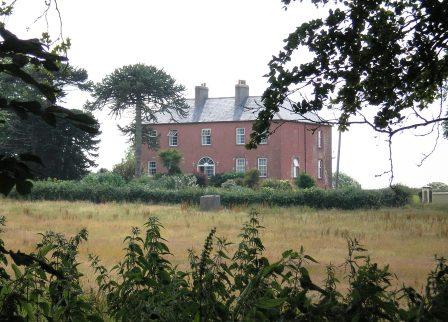
|
| Rathbarry Cottage | Rathbarry Cottage was occupied by Major William Love Peard at the time of Griffith's Valuation. The property was held from the Reverend R. Gumbleton and the buildings were valued at £11. Some ruined walls remain at the site. | |
| Rathbarry Vicarage/Rectory | Lady Carbery was leasing Rathbarry Vicarage to Rev. H. Stewart at the time of Griffith's Valuation, when it was valued at £20. Labelled as Rectory on the later 25-inch Ordnance Survey map, it is now known as Rathbarry House. |

|
| Rathbaun | Home of Simon P. Creagh in 1814 and of his son Pierce Creagh in 1837. Occupied by John Hickey at the time of Griffith's Valuation who held the house from Pierce Creagh. The house is no longer extant. | |
| Rathbraughan | The 1st edition OS map indicates the house at this location was known as Auburn Cottage. At the time of Griffith's Valuation it was occupied by Edward Smith {Smyth] leasing from William Green and valued at £23. McTernan writes that Smyth was the agent for Lord Palmerston's estate. At times it was leased by members of the Gethin family. It was demolished in the 1980s when Rathbraughan housing estate was built. | |
| Rathcarrick | At the time of Griffith's Valuation there were two substantial houses at Rathcarrick, barony of Carbury, both belonging to the Walker estate. John McHutcheon was leasing one property valued at £18 while Amy Eliza Walker was leasing the second, valued at £28. In 1906 John F. Walker was the owner of a house at Rathcarrick, then valued at £63. Rathcarrick house is still extant and has recently been renovated. |

|
| Rathclare | Clare Cottage was originally a residence on the Egmont estate which Hajba writes was leased to the Norcott family. Occupied by Martha Bullen in the early 1850s when the house was valued at £13. A much larger house was constructed in the mid 19th century incorporating the original building. By the end of the 19th century the home of the Burdon family who were still resident in 2002. In 2012 it was being offered for sale. |

|
| Rathclogh Cottage | A small residence when marked on the first Ordnance Survey map. Occupied by Charles Minchin in 1850, valued at £13+ and held from John Millett. | |
| Rathcloheen | Rathcloheen was the home of John Mathew in the first half of the 19th century. The house is situated very close to Thomastown Castle. At the time of Griffith's Valuation John Mathew held Rathcloheen from Lynn Carew and the buildings were valued at £20. "Burke's Irish Family Records" refers to John Smithwick of Rathclogheen, county Tipperary who married Cherry Pennefather in 1823. This house is well preserved and is still used as a residence. |

|
| Rathcool | Blake Esq was resident at Racool in the 1770s. In 1840 the Ordnance Survey Name Books describe Rathcool as "a castle apparently inhabited. There is another dwelling house attached with a garden". In the mid 19th century Rathcool Castle was occupied by Charles Blackmore and held from the representatives of L. Clutterbuck. The buildings were valued at £16.13 shillings. Charles Blackmore was still residing at Rathcool in the 1870s when he is recorded as the owner of one acre in county Tipperary. Rathcool is still in use as a house. |
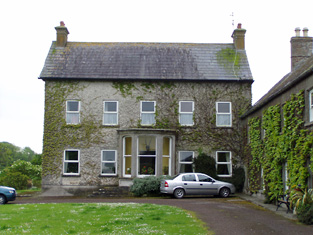
|
| Rathcormac | In 1786 Wilson refers to "Rathcormuck" as the seat of Lord Riversdale. | |
| Rathcoursey House (East) | At the time of Griffith's Valuation a house in Rathcoursey East valued at £18 was held by Richard Lyons from the Provost and Fellows of Trinity College, Dublin. This house is still a residence. |

|
| Rathcoursey House (West) | Home of the Smith family in the 18th and 19th centuries. John Tynte Smyth lived here in the 1770s. Occupied by John Smith in 1814 and John J. Smyth in the early 1850s. The house was valued at £35 and held from the Marquess of Thomond with 214 acres. It is now run as a guest house. |

|
| Rathdonnell House | James Hamilton was leasing this property from the estate of Reverend William Alexander at the time of Griffiths Valuation in the 1850s when it was valued at £7. Local sources suggest it had come into the Alexander family through their mother, Dorothy McClintock. | |
| Rathduane | The home of Owen McCarthy in 1814, of J.E. McCarty [Jeremiah Eugene] in 1837 and of Eugene McCarthy at the time of Griffith's Valuation when the buildings were valued at £20 and held from Sir Broderick Chinnery. Still a McCarthy home in the 1870s. | |
| Rathduff | A house occupied by Thomas Kennedy and held from the Reverend John W. Hackett and partners in the mid 19th century when the buildings were valued at £16.15 shillings. | |
| Rathellen | McTernan writes that Rathellen was built at the beginning of the nineteenth century as a dower house for the Wood of Woodville estate.. It was purchased by Henry Lyons in 1860 and remained in the Lyons family until the 1940s. It is still extant but unoccupied. | |
| Rathfadden Cottage | In1850 this property was leased by Joshua W. Strangeman from the Corporation of Waterford. | |
| Rathfranpark | ||
| Rathfranpark | In 1894 Slater refers to Rathfranpark as the residence of Edmund Knox. At the time of Griffith's Valuation this townland was part of the Palmer estate and leased by Thomas Scott. The house on the property at that time was valued at almost £2. There is still a house at this site. | |
| Rathfredagh | This house was erected post Griffith's Valuation. The Irish Tourist Association surveyor dates it to about 1870. It was the home of James Waller O'Grady a grandson of the 1st Viscount Guillamore and of the 3rd Baron Massy. In 1906 Richard O'Grady, eldest son of James Waller O'Grady (born 1867) was living here. The house was valued at £41.15 shillings. Seat of the 8th and 9th Viscount Guillamore and in the mid 1960s the O'Gradys gave this house to the Cheshire Homes Foundation. It opened as the fifth Cheshire Home in Ireland in 1971. http://www.cheshire.ie/centres_rathfredagh.asp |

|
| Rathglass | In 1814 Rathglass House was the residence of Bernard Rochford. In November 1850 Mark Lynch was occupying the house. At the time of Griffith's Valuation it was occupied by James M. Bourchier. It is still extant. |
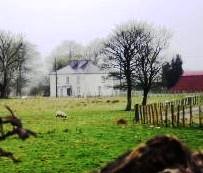
|
| Rathgormuck Castle | The buildings in the vicinity of Rathgormuck Castle were valued at £10 in 1850 and leased by Walter Mansfield to Thomas Terry. On the first edition Ordnance Survey map the castle is described as "in ruins". | |
| Rathgranagher | A house on the Lindsey estate, lived in by Charles Cromie in the late 1830s. It was occupied by John Jackson at the time of Griffith's Valuation, leasing from Thomas Lindsey, when it was valued at £14. A house is still extant there. |

|
| Rathkeale Abbey | The residence of J. Hewson in 1837 and previously of the representatives of George Lake [Leake] esq. By the time of Griffith's Valuation the Abbey was in the possession of Daniel Griffin who held it from the representatives of William Lake [Leake]. It was valued at £30. Referred to in 1942 as "a substanial well kept mansion" the property of Major Waller. |
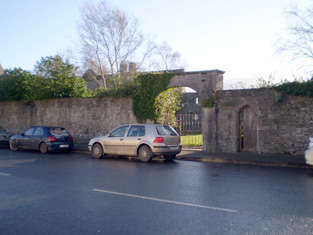
|
| Rathkeery Glebe | Rev. William French was leasing a glebe house at Glebe East, barony of Frenchpark, from Lord de Freyne's estate at the time of Griffith's Valuation when it was valued at £7. The house no longer survives but an entrance gateway and trees indicate its whereabouts. |

|
| Rathlaheen House | A pink three storey house, home of a branch of the Vandeleur family in the 18th and early 19th centuries. In 1786 Wilson refers to it as the seat of Boyle Vandeleur. Also occupied by Boyle Vandeleur in 1814 and by John Scott Vandeleur in 1837 according to Lewis. It was the centre of the famous Rathlaheen Co-operative in the early 19th century. Following the bankruptcy of John Scott Vandeleur in the 1830s Pierce Creagh occupied the house holding it from the Vandeleurs. It later became a Stoney home. They were resident in 1906. The house is no longer extant. | |
| Rathlee | At the time of Griffith's Valuation Thomas Jones was leasing a property valued at £18 at Rathlee, barony of Tireragh, to John Christie. The ''Sligo Directory'' of 1862 indicates that John Christie was a magistrate for the county. McTernan states that this property was associated with the Hewitt family who were connected with the Fitzgerald family through marriage. The Fitzgeralds had acquired an interest in the property at the beginning of the nineteenth century. In 1814 Leet recorded the house at Rathlee as the residence of Michael Fitzgerald. Rathlee is no longer extant but the remains of the walled garden are still visible. | |
| Rathluby | By the end of the 18th century Rathluby was in the possession of the Bridgeman family. The buildings were valued at £5 at the time of Griffith's Valuation when Henry Bridgeman occupied the house which he held from Eliza Piercey and it continued to be a Bridgeman home until the end of the 19th century. The house is now a ruin. | |
| Rathmagurry House | The 1st edition OS map indicates Rathmagurry House at Rathmagurry in Achonry Parish. At the time of Griffith's Valuation William Gawley was leasing a herd's house valued at £2 from the Knox estate at this location. The house is no longer extant. | |
| Rathmaher | Originally a Purcell home which was advertised for sale in May 1850. By the time of Griffith's Valuation this house was owned and occupied by Thomas Wise, valued at £33. In 1944 the Irish Tourist Association Survey reported that this house had been built c.1800 by John Purcell originally of Highfort. It was later occupied by Walpole and Smith families. This house is now a ruin. | |
| Rathmanna | Thomas Ryan of Rathmanna died in 1835 and is buried in the graveyard of St Mary's Church, Thurles. Rathmanna house was occupied by Thomas Ryan in the mid 19th century and held from Messrs Waller and Doherty on a lease dated 1791 James Doherty to Thomas Ryan. It was valued at £22.17 shillings. In 1865 it was advertised for sale with about 340 acres belonging to Thomas Ryan. Rathmanna a substanial and spacious house was in the possession of Michael Cahill in 1873. A building is still located at this site. | |
| Rathmeel | The representatives of William Ormsby were leasing a property valued at £12 at Rathmeel, barony of Tireragh, to Augustus Bolton at the time of Griffith's Valuation. Extensive modern development has taken place in this area. | |
| Rathmore | The property at Rathmore was the residence of Major McCann in 1814. At the time of Griffith's Valuation it was occupied by James McDermott, a family with which it was associated for many years. It had also been recorded as his seat by Lewis in 1837. Earlier, in 1783, Taylor and Skinner recorded it as a seat of the Browne family as did Wilson in 1786. In 1906 it was owned by James McDermott. The house at Rathmore, though smaller than originally, is still extant and occupied. The gatelodge is also extant having undergone extensive renovation. |
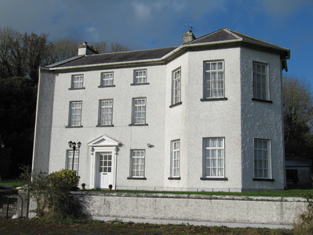
|
| Rathmore House (Kinsale) | Marmaduke Cramer held Rathmore House in fee at the time of Griffith's Valuation, when it was valued at £40. Lewis described it as " a handsome mansion embosomed in flourishing plantations" in 1837 when it was the seat of J. Thomas Cramer. This house is no longer extant. | |
| Rathmoyle | Richard Irwin was leasing a property valued at £35 at Rathmoyle, barony of Castlereagh, from George H. Kirkaldy, at the time of Griffith's Valuation. This property was also recorded as the residence of Richard Irwin in both 1814 and 1837. In 1749 the Census of Elphin recorded that Arthur Irwin, farmer, resided at Rathmoyle. Gormley states that the property continued in the possession of the Irwin family until 1921. The final distribution of land from this estate took place in 1969 and the house was demolished. | |
| Rathmullan House | This property was held in fee by Thomas Batt at the time of Griffiths Valuation in the 1850s when it was valued at £40. The National Inventory of Architectural Heritage suggests the house was originally built by the Knox family around the end of the eighteenth century and later purchased by the Batt family. It is still extant and now operates as a luxury hotel. |
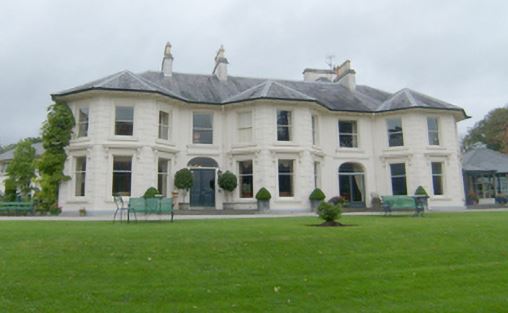
|
| Rathneaveen | No house is named on the first edition Ordnance Survey map for this townland, however later maps show Rathneaveen House. It was built in the mid 19th century as Michael Ryan occupied a house valued at £10.15 shillings in this townland at the time of Griffith's Valuation. Michael Ryan of Rathneaveen is recorded in the 1870s and the house is still extant. | |
| Rathorp | Lewis records Ratope as the residence of the late J. Foster. At the time of Griffith's Valuation it was in the possession of Patrick Geoghegan who held the property from the Marquess of Thomond and 526 acres. The house was valued at £7.10 shillings. A house still exists at the site. |
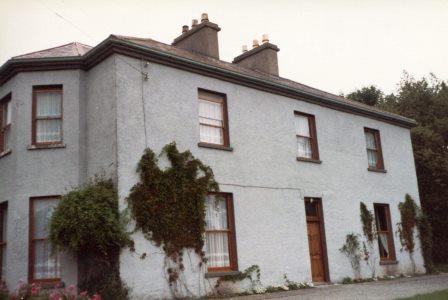
|
| Rathowen | In 1786 Wilson refers to a house which he calls "Rathrone", a mile and a half West of Killala, which was part of the estate of the Bishop of Killala. At that time it was occupied by James Rogers, though Wilson indicates it was the property of Rev. G. Rogers, Chancellor of Dromore. Most of the townland was in the possession of William Kirkwood, leasing from Harriett Gardiner, at the time of Griffith's Valuation. The house is no longer extant. | |
| Rathpeacon House | At the time of Griffith's Valuation, Rathpeacon House was occupied by William le Fanu leasing from Richard Thomas when the house was valued at £27. In the 1870s it is recorded as the residence of John Davis. | |
| Rathpeak House [Woodpark Lodge] | Owen Lynch was occupying the house at Rathpeak at the time of Griffith's Valuation when it was valued at £14. Lewis records Woodpark as his seat in 1837. This is also the property listed as his residence in 1814. At the time of the first Ordnance Survey in 1837 the house, known as Rathpeak House, is described as "a fine house, three stories high and in tolerable repair". When the property was advertised for sale in the Landed Estates' Court in 1861 Woodpark Lodge was described as a mansion house which originally cost several thousand pounds to build. There is now no sign of the house and there are modern farm sheds at the stables. Family history sources suggest the house was demolished in the latter years of the twentieth century. |
![Photo of Rathpeak House [Woodpark Lodge]](https://landedestates.ie/storage/img/orig/2807.jpg)
|
| Rathpoge | At the time of Griffith's Valuation, Sir William Godfrey was leasing this property to William Hickson. No house is marked in this area on the Ordnance Survey map, the only buildings being the Kilcolman farmyard. The buildings on the site were valued at £13. It was still in the possession of the Godfrey estate in 1906 with the same valuation but are no longer extant. | |
| Rathroe | Hajba records a lease of Rathroe House from Sir Robert Deane to Denis McCarthy dated 1779. In 1837 another Denis McCarthy was occupying the house and he was also resident in the early 1850s when the house was held from the Reverend Nicholas Chinnery. The buildings were valued at £26.15 shillings. Hajba writes that the McCarthys continued to live in the house until it was sold in the 1930s to Con Meaney TD. The house is no longer extant. | |
| Rathronan House | A property granted to John Walsh in 1679. Lewis describes this house as the "elegant residence of Major General Sir Hugh Gough". Viscount Gough was still resident in the mid 19th century when the buildings were valued at £47+ and held from Major William M. Hamerton. This property was in the possession of the Whalley family in the late 19th century. A house is still extant at the site. | |
| Rathtermon | Taylor and Skinner indicate Rathtermon as a seat of the Fleming family in 1783. In 1837 Lewis records Rathtermon as the seat of J. Flanagan. At the time of Griffith's Valuation, Rev. John Flanagan was leasing a property valued at £10 together with over 200 acres at Rathtermon, barony of Coolavin, to Phillip McDermott. Rathtermon is still the focus of a large farming enterprise. |

|
| Rathurles | Rathurles was the home of the Brereton family in the 19th century. Occupied by John Brereton in 1814 and T. Brereton in 1837. In 1840 the Ordnance Survey Name Books refer to it as "a modern building". Thomas Brereton was still resident at the time of Griffith's Valuation holding the property valued at £27.15 shillings from Patrick Kernan. Home of Hugh Finch in the 1870s. This house is still extant and occupied. |
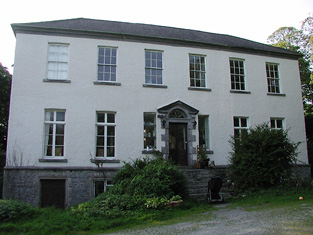
|
| Rathville | At the time of Griffith's Valuation, John Blake was the holder of a property at Carrowreagh, barony of Athenry, valued at £10. Rathville House is still extant and occupied. In 2013 it was offered for sale. |

|
| Ratra House & Stables | Lord de Freyne held a house valued at £4 10s at Ratra, barony of Frenchpark, at the time of Griffith's Valuation. In 1814 Ratra was the residence of Henry Irwin. A house, labelled Ratra, is shown on the 1st edition Ordnance Survey map. A larger building, on a different site, is labelled Ratra House on the later 25-inch edition [M684939]. Neither of these house are extant now. Offices, the property of Lord de Freyne's estate and valued at £7 10s, were located at Clashcarragh, barony of Frenchpark, at the time of Griffith's Valuation. |

|
| Rattoo A | Wilson Gun was leasing a property to John Hanlon at the time of Griffith's Valuation, when it was valued at £8 10s. This may be the building shown on the Ordnance Survey maps adjacent to the area known as The Paddock and not far from the farmyard. Buildings are still extant at these locations. | |
| Rattoo House | At the time of Grffith's Valuation, Rattoo House, in the possession of Wilson Gun, was valued at £20. Lewis refers to Rattoo Lodge as the residence of W.T. Gun in 1837. This would appear to be the house which Bary states was built by Wilson Gun in 1836. The 1st editon Ordnance Survey map, however, indicates "Rattoo House (in ruins)", south west of the Round Tower, which would suggest there was an earlier house also known by this name. In 1906 it was owned by William T.J. Gun and valued at £63. The house remained in the Gun family and their descendents until the early twentieth century when it was sold to the Land Commission by Ella Browne, grand-daughter of Wilson Gun. The Irish Tourist Association Survey, however, still describes it as in her possession "a large straggling building with fourteen bedrooms and fine sittingrooms". It is still extant and occupied. In 2010 it was offered for sale. |

|
| Ravenswood or Monroe House | Michael Roberts was leasing this property to Ralph Westropp at the time of Griffith's Valuation, when it was valued at £38. On the 1st edition Ordnance Survey map it is labelled Monroe House but later came to be known as Ravenswood House. Monroe House appears at a different location (W715627) on the 25-inch Ordnance Survey Map of the 1890s. Ravenswood was occupied by the Westropp family until the twentieth century. |

|
| Rawleystown Court | Lewis writes that "in the parish of Cahercorney are the remains of Raleighstown, an ancient building erected by the uncle of Sir Walter and afterwards the property of the Croker family, who built a splendid house here, now in ruins". The Ordnance Survey Name Book states that the house was built about 75 years previously by the Crokers and that it was afterwards sold to one of the workmen employed in building it who immediately destroyed it. In 1786 Wilson refers to "Rawlen's-town/Rawleigh's-town" as a seat of the Croker family. The first Ordnance Survey map marks the house as a ruin. | |
| Raymoghy | William Montgomery was leasing this property from James Law at the time of Griffiths Valuation in the 1850s, when it was valued at £10. The site is now occupied by farm buildings. | |
| Rea | William Talbot Crosbie's estate owned this property at the time of Griffith's Valuation, when it was valued at £5 15s. The original house is not extant now. | |
| Red Castle (Inishowen) | James S. Doherty held the property known as Red Castle in fee at the time of Griffiths Valuation in the 1850s, when it was valued at £40. In 1837 Lewis referred to Red Castle as the residence of Atkinson Wray. Buildings at the site are labelled Red Castle on all editions of the Ordnance Survey map. By 1906 it was the property of E. Cochrane. The building complex in Redcastle Demesne, was divided between the townlands of Carrickmaquigley and Tullynavinn and valued at £48. The Red Castle Hotel is now located at this site. | |
| Red Castle Villa | Catherine Doherty was occupying Red Castle Villa at the time of Griffiths Valuation in the 1850s, when it was valued at £24. It is no longer extant. | |
| Red Castle Villa | Catherine Doherty was occupying Red Castle Villa at the time of Griffiths Valuation in the 1850s, when it was valued at £24. It is no longer extant. | |
| Redcastle | James S. Doherty held the property known as Red Castle in fee at the time of Griffiths Valuation in the 1850s, when it was valued at £40. Buildings at the site are labelled Red Castle on all editions of the Ordnance Survey map. Now the site of the Redcastle Hotel. | |
| Redcity | In the mid 19th century William Harney held a house valued at £11+ from Sir John Power in the townland of Redcity. Buildings are still located at this site. | |
| Redcliff Lodge / Foildarrig | At the time of Griffith’s Valuation James Hickson held a property, valued at over £21, at Brackloon.On the 1st edition OS map it is labelled Foildarrig. By 1895 it had become known as Red Cliff. Bary states that Hickson built it as a summer residence when he worked as the agent for Lord Landsdowne. It was later owned by the Catholic church and more recently operated as a guesthouse. In 2003 it was offered for sale. | |
| Redhill | At the time of Griffith's Valuation, William Baker was leasing a property valued at £14 at Mullaghroe, barony of Coolavin, from Viscount Lorton's estate. Lewis recorded Redhill as the seat of Andrew Baker in 1837. The house remained in the Baker family until 1912. It is still extant and occupied. |

|
| Redhill House | The Whyte family were resident at Redhill from the 17th century. The first edition Ordnance Survey map (publ. 1837) marks a building in ruins which was the original castle. A house was built to the north east. The Ordnance Survey Field Name Book states that Redhill lately belonged 'to Mr White now in France, estate in Chancery, executors Mr Boyd of Cootehill and Col Clements'. The house 'is a small tho' convenient building with out-houses, the ancient castle in ruins, destroyed by fire 40 years ago.....The house is unoccupied except by a care taker’. Following the death of Francis Melville Whyte in 1833, Redhills was inherited by his niece Georgina Mary Enderby. She married the Reverend Edmund Burke Venables in 1847. Named on the first edition Ordnance Survey map (publ. 1837), Redhills was the residence of the Reverend E.B.W. Venables at the time of Griffith’s Valuation. Valued at £8, he held it in fee. Redhills was the home of the Reverend Arthur Thellusson Oddie in 1905 when he assumed the name and arms of Whyte Venables. In 1906, Georgina Whyte Venables is recorded as occupant when the mansion house was valued at £53.10.0. A building still stands on this site and the gate lodge survives. |

|
| Redmondstown | In 1814 Redmondstown was the residence of J. Parson Ducket and in 1837 of a member of the Quinn family. In the early 1850s R.G. Fitzgerald was the occupier, holding the house valued at £16.15 shillings from the Earl of Glengall. This house is still extant and is located in a wooded area. Thomas Albert Quin of Redmondstown owned 612 acres in the 1870s. | |
| Redmounthill Farm | At the time of Griffith's Valuation the property at Ballynamudagh, a steward's house and out buildings valued at £14, were part of the Pollok estate. In 1906 this property was valued at £41. On the 25-inch Ordnance Survey map of the 1890s the buildings are labelled Redmounthill Farm. The house and some portions of the farm buildings remain at the site. |

|
| Redwood | Marked on the first edition Ordnance Survey map as Moatfield House and on later maps as Redwood. Moate-field, Burris-a-kane, was the home of William Clarke in 1814. In 1841 the Ordnance Survey Name Books refer to it as "Moat Field, a good dwelling house the residence of Miss Clarke". In the mid 19th century Robert Daly held a house valued at £15 and 324 acres in Redwood from Lord Bloomfield. Redwood is still extant. | |
| Redwood House | Redwood was the home of the Bloomfield family in county Tipperary, occupied by Major Bloomfield in 1837. In 1840 the Ordnance Survey Name Books mention that Redwood was "a commodious house, at present occupied by a party of the constabulary and also the residence of Mr. Ryan, under-agent to Maj. Bloomfield". It is marked as a police station on the 1st edition Ordnance Survey map. At the time of Griffith's Valuation. Phillip Crawley held the property from Lord Bloomfield and the house was valued at £15. Redwood House later became a Trench home, valued at £18.15 shillings in 1906. It no longer exists. | |
| Reeks View | Rev. William de Moleyns was leasing this property from Lord Ventry's estate at the time of Griffith's Valuation, when it was valued at £4 15s, on a holding of 140 acres. It appears on the 1893 edition of the Ordnance Survey map as Reeks View. It is still extant. | |
| Reen Lodge | Leased by Robert White from the Bantry estate in 1852 when the house was valued at £10+. Noted by Leet as the residence of Rev. William Hodnett in 1814. In the later half of the nineteenth century it seems to have been occupied by the Leonard family. Documents in relation to it exist in the Bantry Estate papers. The Irish Tourist Association survey in the 1940s refer to it as owned by Mr. Regan. It is still extant and occupied. | |
| Reenadisert Court | Leased by Robert Warren from the Bantry estate at the time of Griffith's Valuation when it was valued at almost £6. It was originally a seventeenth century fortified house built by the O'Sullivans and is now in ruins. A second property, Reenadisert Cottage (W000531), appears on the 25-inch Ordnance Survey map of the 1890s but this has now disappeared. |

|
| Reenmeen Cottage | Leased by Robert White from the Bantry estate in 1852 when it was valued at £11+. Named as Reenmeen Cottage by Lewis who notes it as the seat of R. White in 1837. Buildings still exist at the site. A house named Glengarriff Cottage (V939564) appears on the 1st edition Ordnance Map in this townland but is not visible on the later 25-inch map. | |
| Reenmore House | Rev. John Day was leasing a property valued at £12 15s from the Lansdowne estate at the time of Griffith's Valuation. This may have been the conjoined property labelled Sound House and Fir View on the 1st edition Ordnance Survey Map. On the 25-inch map of the 1890s, Sound House has become known as Reenmore House. The are still extant buildings at the site. | |
| Reenydonagan House | Leased by Roger O'Sullivan from the Kenmare estate in 1852 when it was valued at £12. Lewis notes it as the seat of D. O'Sullivan in 1837. The house is still extant and operates as a guesthouse. |

|
| Regaile | In 1840 the Ordnance Survey Name Books record Rev. Mr. Joice as the occupant of Regeale. The Reverend Robert Armstrong occupied the house at the time of Griffith's Valuation holding it from Richard Phillips. The buildings were valued at £20.18 shillings.A house is still extant at Regaile. | |
| Rehill | Rehill was occupied by William Fennell in 1814 and 1837 but by the time of Griffith's Valuation James Mulcahy was resident, holding the property from the Earl of Glengall. The buildings which included a house, offices and corn mill were valued at £62. Sold in 1853 to Robert Murdock and leased by him to Edward Mulcahy. A building is still located as this site. | |
| Renmore House | The residence of Patrick Marcus Lynch and his descendants on the outskirts of Galway from the early 19th century, leased from the Governors of the Erasmus Smith Schools. It was valued at £35 at the time of Griffith's Valuation. The house was sold circa 1924 and became a tuberculosis sanitorium. It is now part of a Health Service facility. |
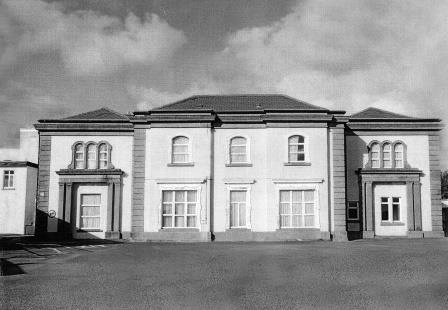
|
| Rennies Cottage | Built by Luke Joseph Shea in the 1830s, he held this property in fee at the time of Griffith's Valuation, when it was valued at £28 with an adjacent mill. A building is still extant at the site. | |
| Renny | This house, overlooking the River Blackwater, may have been part of the Widenham estate which passed to the Smyths. The site had earlier associations with the poet Edmund Spenser. Wilson, writing in 1786, refers to "Rinny, the seat of Mr. Nagle, which was formerly part of the estate of the immortal Spenser". In 1814 the Reverend C.P. Wallis was the occupant. At the time of Griffith's Valuation the house was occupied by Henry Smith who held the property in fee, the buildings were valued at £23. Henry Smyth advertised the house and 541 acres for sale in May 1851, all it required at that time was a "small outlay in paint and paper to make it at once fit for occupation". In 1885 Walford noted Renny as the seat of John Blackburne. Hajba writes that the last occupant was Captain [Pepper] Roberts. The Earl of Listowel demolished the house following the Captain's death in 1900 though many of the buildings shown on the 1st edition Ordnance Survey map had already disappeared by then. | |
| Renvyle | The house at Renvyle was inhabited by the O'Flahertys in 1811 and was described by Henry Blake in his ''Letters from the Irish Highlands''.The Blakes went to live at Renvyle in the early 1820s and an additional storey was added in the mid 19th century. Run as a guest house in the 1880s, it was bought by Oliver St John Gogarty in 1917. Badly burnt in 1923 he rebuilt it as a hotel. |

|
| Retreat/Faybrook | Retreat, set in a small demesne close to Dromore River with a corn mill nearby, is named on the first edition six inch Ordnance Survey map (publ. 1837). It appears to have been a Bredin home in the early 1850s. By the time of Griffith’s Valuation it belonged to Thomas Fay and was occupied by James Boyle. The rateable valuation was £10. The house reduced in size, or possibly a new structure, was renamed Faybrook. It is marked on the 25 inch map and is still extant. | |
| Ricehill House | Rice Hill was built in the mid-18th century. It was the home of the Bredin family in the first half of the 19th century. It is named on the first edition six inch Ordnance Survey map (publ. 1837). Described by Mulligan as a ‘classic Georgian gentleman’s farmhouse in a small demesne.’ Occupied by Patrick Finnegan and held from the representatives of Sophia Wright in the 1850s, when the buildings were valued at £3.10.0. It was still the home of the Finnegan family at the beginning of the 20th century and continues to be a residence. |

|
| Rich Hill | The residence of the Howley family in the 19th century, held by them in fee and valued at £39 in the early 1850s. Rich Hill was also the childhood home of Captain William O'Shea. |

|
| Rich Hill | A house occupied by Thomas George French at the time of Griffith's Valuation, valued at £20 and held by him in fee. | |
| Richfordstown House | Thomas Lucas was leasing this property from the Smith-Barry estate at the time of Griffith's Valuation, when it was valued at £26. It was the seat of Jasper Evans Lucas in 1814. In the 1870s John R. Lucas was the owner of the property. There is now a large farming enterprise here, as well as a house which may have replaced the earlier house. |

|
| Richmond | Located in the town of Fermoy, Richmond was occupied by H. Smyth in 1837 and by George Walker. It was the residence of the Furlong family in the second half of the 19th century. In the 1920s they sold the house to the Loreto Sisters. Still part of the convent complex at the beginning of the 21st century. |

|
| Richmond | The home of the Mannix family in the late 18th and 19th centuries. Occupied by S. Oliver in 1814 and by R. Mannis [Mannix] in 1837. [Henry Mannix was resident in the early 1850s when the house was valued at £27 and held from Jonas Morris.] A house is still extant at the site. | |
| Richmond | Bence Jones writes that this was a fortified house onto which a three storey house was built in 1733. The house was later altered and expanded. Richmond was the seat of the Gason family in the 18th and 19th centuries, originally known as Killashalloe. Occupied by Richard Gason in 1814 and in 1837 and held by him in fee in the early 1850s when it was valued at £46. This house remained in Gason possession until 1956 when the roof was removed and the farm was sold in 1962. Part of the facade of the Ulster Bank headquarters at George's Quay, Dublin, was constructed from blocks of stone from Richmond House (''The Irish Independent'', 16 March 1999) . | |
| Richmond House (Affane) | Maj John H. Alcock was leasing this property from Henry Dennehy at the time of Griffith's Valuation when it was valued at £29. Lewis also noted it as his seat in 1837. The National Inventory of Architectural Heritage indicates it was also linked with the Villiers Stuart family. It is still extant and occupied. |

|
| Richmond Villa | This house valued at £16 in the mid 19th century was occupied by the Westropp family from at least 1814, although a Mrs Wallace was in residence in 1837. The Reverend Fitzgerald records a Mr William Wallace as resident in the 1820s and that the house was built about 70 years previously. It was situated on the Tomkins estate. |

